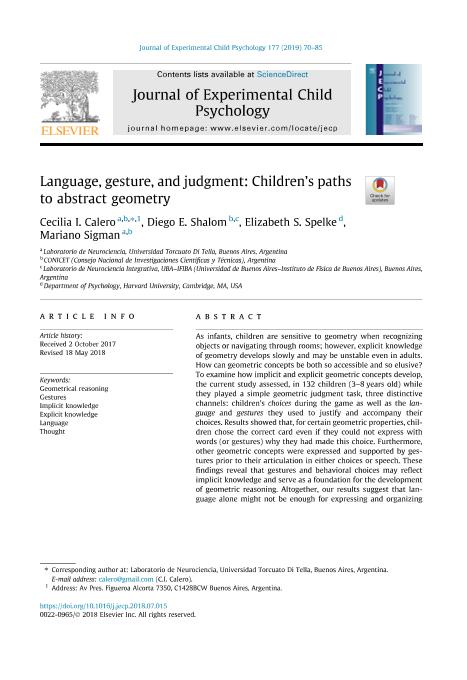Artículo
Language, gesture, and judgment: Children's paths to abstract geometry
Fecha de publicación:
10/2018
Editorial:
Academic Press Inc Elsevier Science
Revista:
Journal of Experimental Child Psychology
ISSN:
0022-0965
Idioma:
Inglés
Tipo de recurso:
Artículo publicado
Clasificación temática:
Resumen
As infants, children are sensitive to geometry when recognizing objects or navigating through rooms; however, explicit knowledge of geometry develops slowly and may be unstable even in adults. How can geometric concepts be both so accessible and so elusive? To examine how implicit and explicit geometric concepts develop, the current study assessed, in 132 children (3–8 years old) while they played a simple geometric judgment task, three distinctive channels: children’s choices during the game as well as the language and gestures they used to justify and accompany their choices. Results showed that, for certain geometric properties, children chose the correct card even if they could not express with words (or gestures) why they had made this choice. Furthermore, other geometric concepts were expressed and supported by gestures prior to their articulation in either choices or speech. These findings reveal that gestures and behavioral choices may reflect implicit knowledge and serve as a foundation for the development of geometric reasoning. Altogether, our results suggest that language alone might not be enough for expressing and organizing geometric concepts and that children pursue multiple paths to overcome its limitations, a finding with potential implications for primary education in mathematics.
Archivos asociados
Licencia
Identificadores
Colecciones
Articulos(IFIBA)
Articulos de INST.DE FISICA DE BUENOS AIRES
Articulos de INST.DE FISICA DE BUENOS AIRES
Articulos(SEDE CENTRAL)
Articulos de SEDE CENTRAL
Articulos de SEDE CENTRAL
Citación
Calero, Cecilia Ines; Shalóm, Diego Edgar; Spelke, Elizabeth S.; Sigman, Mariano; Language, gesture, and judgment: Children's paths to abstract geometry; Academic Press Inc Elsevier Science; Journal of Experimental Child Psychology; 177; 10-2018; 70-85
Compartir
Altmétricas




